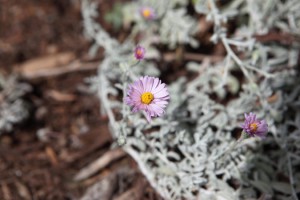FALL-BLOOMING PERENNIAL BORDER: BRACHYSCHOME VS. ASTER
By Cassy Aoyagi: Beautiful Brachyschome multifida and California native Aster chilensis perform well in dry climates and rocky soils, producing sprays of delicate, daisy-like lavender flowers that last into fall.
Aster Chilensis – Bird and Butterfly Feeders
A favorite for its versatility and vibrance in the garden, amazing California Aster performs well almost anywhere below 4500 feet, from coasts and bluffs to inland at low altitudes. Aster:
- Blooms While Others Rest. Clusters of purple flowers create bouquets from late summer to fall, ensuring a garden’s vibrance when other natives are gearing up for next season’s growth.
- Holds Soil in Place. Aster chilensis grows very low, like a mat and will cover every inch of bedrock, where no other plant will take hold. Although not deeply rooted, it reduces annoying surficial erosion.
- Needs Little Water. Use Aster on a slope, in a container or just along a border in the landscape and save a substantial amount of water.
- Brings Bird and Butterflies! Native varieties are delightfully attractive to both birds and butterflies.
Ready to invite Aster into your garden? When used as a border or in a container garden, we like pairing Aster with larger specimens with deeper roots like Manzanita or spharalcea. Because the hugging varieties will withstand light foot traffic, its also a great companion to the meadow-like versions of our FormLA® IdealMow™ Lawn Alternatives.
Brachyschome Multifida – Slug and Snail Bait

While many Brachyschomes varieties do not perform well in California, Brachyschome multifinda shares many cultural similarities with native Aster. Native to Australia, Tasmania, New Zealand and New Guinnea, its downsides are slight. Brachyschome multifida:
- Needs More Maintenance. A great late summer bloomer, Brachyschome needs some dead heading to keep up appearances.
- Sticks to One Place. While we like that Brachyschome multifinda is non-invasive, its lack of interest in spreading makes it an unreliable slope cover, a service Aster performs quite well.
- Wants Water. While relatively drought tolerant, particularly by the coast, even plants this climate-compatible are no match for a California native.
- Attracts Slugs and Snails. Brachyschome’s biggest challenge is its potential to attract slugs and snails.
For more guidance on where to plant big dry ones, see our past Wet-to-Dry Exchange articles.
